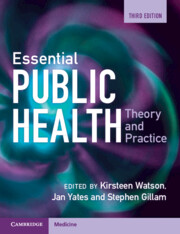Book contents
- Essential Public Health
- Essential Public Health
- Copyright page
- Contents
- Contributors
- Foreword
- Acknowledgements
- Introduction
- Part 1 The Public Health Toolkit
- Part 2 Contexts for Public Health Practice
- Introduction to Part 2: What Do We Mean by Contexts in Public Health?
- 11 The Health of Children and Young People
- 12 Adult Public Health and Non-Communicable Diseases
- 13 Public Health and Ageing
- 14 Health Inequalities and Public Health Practice
- 15 Health Policy
- 16 International Development and Public Health
- 17 Planetary Health
- Glossary
- Index
- References
13 - Public Health and Ageing
from Part 2 - Contexts for Public Health Practice
Published online by Cambridge University Press: 01 December 2023
- Essential Public Health
- Essential Public Health
- Copyright page
- Contents
- Contributors
- Foreword
- Acknowledgements
- Introduction
- Part 1 The Public Health Toolkit
- Part 2 Contexts for Public Health Practice
- Introduction to Part 2: What Do We Mean by Contexts in Public Health?
- 11 The Health of Children and Young People
- 12 Adult Public Health and Non-Communicable Diseases
- 13 Public Health and Ageing
- 14 Health Inequalities and Public Health Practice
- 15 Health Policy
- 16 International Development and Public Health
- 17 Planetary Health
- Glossary
- Index
- References
Summary
The proportion of the population living into old age has been increasing worldwide. For the first time in history, there are more older people than children under 5 years of age. The task for public health is to understand the relationships between ageing, health and the environment (physical, social and economic) in which people live, to promote healthy ageing and prevent the disability and subsequent dependency that is often associated with growing old.
This chapter examines the factors that lead to ageing populations and explores the health, social and economic consequences of the change in the population structure. It then goes on to outline strategies that can lead to healthy ageing and other public health actions that could help to manage the challenges posed – and the opportunities afforded – by the relative and absolute increase in the number of older people.
Keywords
- Type
- Chapter
- Information
- Essential Public HealthTheory and Practice, pp. 249 - 264Publisher: Cambridge University PressPrint publication year: 2023



